Occurrence of Graphite-Like Carbon in Podiform Chromitites of Greece and Its Genetic Significance
Abstract
:1. Introduction
2. Materials and Methods
3. Characteristics of Ophiolites and Chromitites
3.1. Characteristics of Ophiolites
3.2. Characteristics of Graphite-Bearing Chromitites
3.2.1. Skyros (Achladones)
3.2.2. Othrys (Eretria)
3.2.3. Pindos (Milia)
3.2.4. Veria
4. Results
4.1. Mineralogical Characteristics
4.2. Geochemical Characteristics
5. Discussion
5.1. Abiotic Methane and Graphite
5.2. A Comparison between Graphite-Like Carbon in Chromitites of Greece and Other Chromitites and Peridotites
5.3. Stability of Silicate Minerals, Graphite, and Alloys in Chromitites
5.4. The Role of the Ruthenium (PGE) Content
6. Conclusions
Author Contributions
Funding
Acknowledgments
Conflicts of Interest
References
- Economou, M.; Dimou, E.; Economou, G.; Migiros, G.; Vacondios, I.; Grivas, E.; Rassios, A.; Dabitzias, S. Chromite Deposits of Greece: Athens; Theophrastus Publications: Athens, Greece, 1986; pp. 129–159. [Google Scholar]
- Melcher, F.; Grum, W.; Simon, G.; Thalhammer, T.V.; Stumpfl, E. Petrogenesis of the ophiolitic giant chromite deposit of Kempirsai, Kazakhstan: A study of solid and fluid inclusions in chromite. J. Petrol. 1997, 10, 1419–1458. [Google Scholar] [CrossRef]
- Proenza, J.A.; Gervilla, F.; Melgarejo, J.C.; Bodinier, J.L. Al- and Cr-rich chromitites from the Mayarí-Baracoa ophiolitic belt (eastern Cuba); consequence of interaction between volatile-rich melts and peridotites in suprasubduction mantle. Econ. Geol. 1999, 94, 547–566. [Google Scholar] [CrossRef]
- Garuti, G.; Zaccarini, F.; Economou-Eliopoulos, M. Paragenesis and composition of laurite from the chromitites of Othrys (Greece): Implications for Os-Ru fractionation in ophiolitic upper mantle of the Balkan Peninsula. Miner. Depos. 1999, 34, 312–319. [Google Scholar] [CrossRef]
- Beccaluva, L.; Coltorti, M.; Saccani, E.; Siena, F. Magma generation and crustal accretion as evidenced by supra-subduction ophiolites of the Albanide-Hellenide Sub Pelagonian zone. Island Arc 2005, 14, 551–563. [Google Scholar] [CrossRef]
- Rassios, A.; Konstantopoulou, G. Emplacement tectonism and the position of chrome ores in the Mega 710 Isoma peridotites, SW Othris, Greece. Bull. Geol. Soc. Greece 1993, 28, 463–474. [Google Scholar]
- Rassios, A.; Dilek, Y. Rotational deformation in the Jurassic Mesohellenic Ophiolites, Greece, and its 718 tectonic significance. Lithos 2009, 108, 207–223. [Google Scholar] [CrossRef]
- Gervilla, F.; Padrón-Navarta, J.A.; Kerestedjian, T.; Sergeeva, I.; González-Jiménez, J.M.; Fanlo, I. Formation of ferrian chromite in podiform chromitites from the Golyamo Kamenyane serpentinte, Eastern Rhodopes, SE Bulgaria: A two-stage process. Contr. Mineral. Petrol. 2012. [Google Scholar] [CrossRef]
- Colás, V.; González-Jiménez, J.M.; Griffin, W.L.; Fanlo, I.; Gervilla, F.; O’Reilly, S.Y.; Pearson, N.J.; Kerestedjian, T.; Proenza, J.A. Fingerprints of metamorphism in chromite: New insights from minor and trace elements. Chem. Geol. 2014, 389, 137–152. [Google Scholar] [CrossRef]
- González-Jiménez, J.M.; Locmelis, M.; Belousova, E.; Griffin, W.L.; Gervilla, F.; Kerestedjian, T.N.; Pearson, N.J.; Sergeeva, I. Genesis and tectonic implications of podiform chromitites in the 806 metamorphosed Ultramafic Massif of Dobromirtsi (Bulgaria). Gondwana Res. 2015, 27, 555–574. [Google Scholar] [CrossRef]
- Pujol-Solà, N.; Proenza, I.A.; Garcia-Casco, A.; González-Jiméne, J.M.; Andreazini, A.; Melgarejo, J.C.; Gervilla, F. An Alternative Scenario on the Origin of Ultra-High Pressure (UHP) and Super-Reduced (SuR) Minerals in Ophiolitic Chromitites: A Case Study from the Mercedita Deposit (Eastern Cuba). Minerals 2018, 8, 433. [Google Scholar] [CrossRef]
- Arai, S. Conversion of low-pressure chromitites to ultrahigh-pressure chromitites by deep recycling: A good inference. Earth Planet. Sci. Lett. 2013, 379, 81–87. [Google Scholar] [CrossRef] [Green Version]
- Ballhaus, C.G.; Stumpfl, E.F. Occurrence and petrological significance of graphite in the Upper Critical Zone, western Bushveld Complex, South Africa. Earth Plant Sci. Lett. 1985, 74, 58–68. [Google Scholar] [CrossRef]
- Zhou, M.F.; Robinson, P.T.; Su, B.X.; Gao, J.F.; Li, J.W.; Yang, J.S.; Malpas, J. Compositions of chromite, associated minerals, and parental magmas of podiform chromite deposits: The role of slab contamination of asthenospheric melts in suprasubduction zone environments. Gondwana Res. 2014, 26, 262–283. [Google Scholar] [CrossRef]
- Yang, J.S.; Meng, F.; Xu, S.; Robinson, P.T.; Dilek, Y.; Makeyev, A.B.; Wirth, R.; Wiedenbeck, M.; Cliff, J. Diamonds, native elements and metal alloys from chromitite of the Ray-Iz ophiolite of the Polar Urals. Gondwana Res. 2015, 27, 459–485. [Google Scholar] [CrossRef]
- Robinson, P.T.; Trumbull, R.B.; Schmitt, A.; Yang, J.S.; Li, J.W.; Zhou, M.F.; Erzinger, J.; Dare, S.; Xiong, F. The origin and significance of crustal minerals in ophiolitic chromitites and peridotites. Gondwana Res. 2015, 27, 486–506. [Google Scholar] [CrossRef]
- Xiong, F.; Yang, J.; Dilek, Y.; Xu, X.; Zhang, Z. Origin and significance of diamonds and other exotic minerals in the Dingqing ophiolite peridotites, eastern Bangong-Nujiang suture zone, Tibet. Lithosphere 2017, 10, 142–155. [Google Scholar] [CrossRef]
- Farré-de-Pablo, J.; Proenza, I.A.; González-Jiménez, J.M.; Garcia-Casco, A.; Colás, V.; Roqué-Rosse, L.; Camprubí, A.; Sánchez-Navas, A. A shallow origin for diamonds in ophiolitic chromitites. Geology 2018. [Google Scholar] [CrossRef]
- Frost, B.R. On the stability of sulfides, oxides and native metals in serpentinites. J. Petrol. 1985, 26, 31–63. [Google Scholar] [CrossRef]
- McKee, D.W. Carbon and graphite science. Ann. Rev. Mater. Sci. 1973, 3, 195–231. [Google Scholar] [CrossRef]
- Seewald, J.S.; Zolotov, M.Y.; McCollom, T. Experimental investigation of single carbon compounds under hydrothermal conditions. Geochim. Cosmochim. Acta 2006, 70, 446–460. [Google Scholar] [CrossRef] [Green Version]
- Tsikouras, B.; Etiope, G.; Ifandi, E.; Kordella, S.; Papatheodorou, G.; Hatzipanagiotou, K. Methane flux and origin in the Othrys ophiolite hyperalkaline springs, Greece. Chem. Geol. 2013, 347, 161–174. [Google Scholar]
- Brovarone, A.B.; Martinez, I.; Elmaleh, A.; Compagnoni, R.; Chaduteau, C.; Ferraris, C.; Esteve, I.; Brovarone, A.B.; Martinez, I.; Elmaleh, A.; et al. Massive production of abiotic methane during subduction evidenced in metamorphosed ophicarbonates from the Italian Alps. Nat. Commun. 2017, E18, 14134. [Google Scholar] [CrossRef] [PubMed]
- Etiope, G.; Ifandi, E.; Nazzari, M.; Procesi, M.; Tsikouras, B.; Ventura, G.; Steele, A.; Tardini, R.; Szatmari, P. Widespread abiotic methane in chromitites. Sci. Rep. 2018, 8, 8728. [Google Scholar] [CrossRef] [PubMed] [Green Version]
- Etiope, G.; Ionescu, A. Low-temperature catalytic CO2 hydrogenation with geological quantities of ruthenium: A possible abiotic CH4 source in chromitite-rich serpentinized rocks. Geofluids 2015, 15, 438–452. [Google Scholar] [CrossRef]
- Stumpfl, E.F.; Rucklidge, J.C. The platiniferous dunite pipes of the eastern Bushveld Complex. Econ. Geol. 1982, 77, 1419–1431. [Google Scholar] [CrossRef]
- Volborth, A.A.; Housley, R.M. A preliminary description of complex graphite, sulphide, arsenide, and platinum-group element mineralization in a pegmatoid pyroxenite of the Stillwater Complex, Montana, USA. TMPM 1984, 33, 213–230. [Google Scholar] [CrossRef]
- Martín-Méndez, I.; Boixereu, E.; Villaseca, C. Mineralogical and isotopic characterization of graphite deposits from the Anatectic Complex of Toledo, central Spain. Min. Depos. 2016, 551, 575. [Google Scholar] [CrossRef]
- Spray, J.G.; Bébien, J.; Rex, D.C.; Roddick, J.C. Age constraints on the igneous and metamorphic evolution of the Hellenic-Dinaric ophiolites. Geol. Soc. Lond. Spec. Publ. 1984, 17, 619–627. [Google Scholar] [CrossRef]
- Hirsch, P.; Kassens, S.; Puttmann, P.; Reimer, L. Contamination in a Scanning Electron Microscope and the Influence of Specimen Cooling. Scanning 1994, 16, 101–110. [Google Scholar] [CrossRef]
- Postek, M.T. An approach to the reduction of hydrocarbon contamination in the scanning electron microscope. Scanning 1996, 18, 269–274. [Google Scholar] [CrossRef]
- Kapsiotis, A.; Rassios, A.; Antonelou, A.; Tzamos, E. Genesis and Multi-episodic Alteration of Zircon-bearing Chromitites from Ayios Stefanos, Othris Massif, Greece: Assessment of an Unconventional Hypothesis on the Origin of Zircon in Ophiolitic Chromitites. Minerals 2016, 6, 124. [Google Scholar] [CrossRef]
- Moudrakis, D. Introduction to the geology of Macedonia and Trace: Aspects of the geotectonic evolution of the Hellenides. Bull. Geol. Soc. Greece 1992, 30, 31–46. [Google Scholar]
- Economou-Eliopoulos, M. On the origin of the PGE-enrichment in chromitites associated with ophiolite complexes: The case of Skyros island, Greece. In 9th SGA Meeting; Andrew, C.J., Borg, G., Eds.; Digging Deeper: Dublin, Ireland, 2007; pp. 1611–1614. [Google Scholar]
- Tarkian, M.; Eliopoulos, D.; Economou-Eliopoulos, M. Platinum-group minerals and tetraauricuprite in ophiolitic rocks of the Skyros Island, Greece. Mineral. Petrol. 1992, 47, 55–56. [Google Scholar] [CrossRef]
- Economou, M.; Naldrett, A.J. Sulfides associated with podiform bodies of chromite at Tsangli, Eretria, Greece. Mineral. Depos. 1984, 19, 289–297. [Google Scholar] [CrossRef]
- Economou-Eliopoulos, M.; Vacondios, I. Geochemistry of chromitites and host rocks from the Pindos ophiolite complex, northwestern Greece. Chem. Geol. 1995, 122, 99–108. [Google Scholar] [CrossRef]
- Prichard, H.; Economou-Eliopoulos, M.; Fisher, P.C. Contrasting Platinum-group mineral assemblages from two different podiform chromitite localities in the Pindos ophiolite complex, Greece. Can. Mineral. 2008, 46, 329–341. [Google Scholar] [CrossRef]
- Kapsiotis, A.; Grammatikopoulos, T.; Tsikouras, B.; Hatzipanagiotou, K.; Zaccarini, F.; Garuti, G. Chromian spinel composition and Platinum-group element mineralogy of chromitites from the Milia area, Pindos ophiolite complex, Greece. Can. Mineral. 2009, 47, 1037–1056. [Google Scholar] [CrossRef]
- Tsoupas, G.; Economou-Eliopoulos, M. High PGE contents and extremely abundant PGE-minerals hosted in chromitites from the Veria ophiolite complex, northern Greece. Ore Geol. Rev. 2008, 33, 3–19. [Google Scholar] [CrossRef]
- Economou-Eliopoulos, M.; Eliopoulos, D.G.; Tsoupas, G. On the diversity of the PGE content in chromitites hosted in ophiolites and in porphyry-Cu systems: Controlling factors. Ore Geol. Rev. 2017, 88, 156–173. [Google Scholar] [CrossRef]
- Barnes, S.-L.; Naldrett, A.J.; Gorton, M.P. The origin of the fractionation of the platinum-group elements in terrestrial magmas. Chem. Geol. 1985, 53, 203–323. [Google Scholar] [CrossRef]
- Barnes, I.; O’Neil, J.R. The relationships between fluids in some fresh alpine-type ultramafics and possible serpentinization, Western United States. Geol. Soc. Bull. 1969, 80, 1947–1960. [Google Scholar] [CrossRef]
- Kvasnitsa, V.N.; Yatsenko, V.G.; Jaszczok, J.A. Disclinations in unusual graphite crystals from anorthosites of Ukraine. Can. Mineral. 1999, 35, 951–960. [Google Scholar]
- Rodas, M.; Luque, F.J.; Barrenechea, J.F.; Fernandez-Caliani, J.C.; Miras, A.; Fernandez-Rodriguez, C. Graphite occurrences in the low-pressure/hightemperature metamorphic belt of the Sierra de Aracena (southern Iberian Massif). Mineral. Mag. 1999, 64, 801–814. [Google Scholar] [CrossRef]
- Coltice, N.; Simon, L.; Lecuyer, C. Carbon isotope cycle and mantle structure. Geophys. Res. Lett. 2004, 31, L05603. [Google Scholar] [CrossRef]
- Gálvez, M.E.; Beyssac, O.; Martinez, I.; Benzerara, K.; Chaduteau, C.; Malvosin, B.; Malavieille, J. Graphite formation by carbonate reduction during subduction. Nat. Geosci. 2013, 6, 473–477. [Google Scholar] [CrossRef]
- Lian, D.-Y.; Yang, J.-S.; Dilek, Y.; Wu, W.W.; Zhang, Z.-M.; Xiong, F.; Liu, F.; Zhou, W. Deep mantle origin and ultra-reducing conditions in podiform chromitite: Diamond, mois sanite, and other unusual minerals in podiform chromitites from the Pozanti-Karsanti ophiolite, southern Turkey. Am. Mineral. 2017, 102, 1101–1113. [Google Scholar] [CrossRef]
- Dilek, Y.; Yang, J. Ophiolites, diamonds, and ultrahigh-pressure minerals: New discoveries and concepts on upper mantle petrogenesis. Lithosphere 2018, 10, 3–13. [Google Scholar] [CrossRef] [Green Version]
- Xu, X.-Z.; Cartigny, P.; Yang, J.-S.; Dilek, Y.; Xiong, F.; Guo, G. Fourier trans-form infrared spectroscopy data and carbon isotope characteristics of the ophiolite-hosted diamonds from the Luobusa ophiolite, Tibet, and Ray-Iz ophiolite, Polar Urals. Lithosphere 2018, 10, 156–169. [Google Scholar] [CrossRef]
- Satish-Kumar, M.; So, H.; Yoshino, T.; Kato, M.; Hiroi, Y. Experimental determination of carbon isotope fractionation between iron carbide melt and carbon: 12C-enriched carbon in the Earth’s core? Earth Planet. Sci. Lett. 2011, 310, 340–348. [Google Scholar] [CrossRef]
- Luque, F.J.; Crespo-Feo, E.; Barrenechea, J.F.; Ortega, L. Carbon isotopes of graphite: Implications on fluid history. Geosci. Front. 2013, 3, 197–207. [Google Scholar] [CrossRef]
- Van Zuilen, M.A.; Lepland, A.; Arrhenius, G. Reassessing the evidence for the earliest traces of life. Nature 2002, 418, 627–630. [Google Scholar] [CrossRef] [PubMed]
- Lopez-Garcia, P.; Moreira, D.; Douzery, E.; Forterre, P.; Van Zuilen, M.; Claeys, P.; Prieur, D. Ancient fossil record and early evolution (ca. 3.8 to 0.5 Ga). Earth Moon Planets 2002, 98, 247–290. [Google Scholar] [CrossRef]
- Kapsiotis, A.; Economou-Eliopoulos, M.; Zhenga, H.; Sud, B.X.; Lenaz, D.; Jing, J.J.; Antoneloug, A.; Velicogna, M.; Xia, B. Refractory chromitites recovered from the Eretria mine, East Othris massif (Greece): Implications for metallogeny and deformation of chromitites within the lithospheric mantle portion of a forearc-type ophiolite. Chemie der Erde 2019, in press. [Google Scholar]
- Ifandi, E.; Zaccarini, Z.; Tsikouras, B.; Grammatikopoulos, T.; Garuti, G.; Karipi, S. First occurrences of Ni-V-Co phosphides in chromitite from the Agios Stefanos Mine, Othrys Ophiolite, Greece. Ofioliti 2018, 43, 131–145. [Google Scholar]
- Tomkins, A.G.; Rebryna, K.C.; Weinberg, R.F.; Schaefer, B.F. Magmatic sulfide formation by reduction of oxidized arc basalt. J. Petrol. 2012, 53, 1537–1567. [Google Scholar] [CrossRef]
- Gervilla, F.; Essaifi, A.; Wafik, A. Mineralogical and geochemical features of the alteration processes of magmatic ores in the Beni Bousera ultramafic massif (north Morocco). J. Afr. Earth Sci. 2017, 132, 47–63. [Google Scholar]
- Gervilla, F.; Leblanc, M.; Torres-Ruiz, J.; Fenoll Hach-Ali, P. Immiscibility between arsenide and sulfide melts: A mechanism for the concentration of noble metals. Can. Mineral. 1996, 34, 485–502. [Google Scholar]
- Panayiotou, A. Cu-Ni-Co-Fe Sulphide Mineralization, Limassol Forest, Cyprus; Panayiotou, A., Ed.; International Ophiolite Symposium: Nicosia, Cyprus, 1980; pp. 102–116. [Google Scholar]
- Zaccarini, F.; Proenza, A.J.; Ortega-Gutierrez, F.; Garuti, G. Platinum group minerals in ophiolitic chromitites from Tehuitzingo (Acatlan complex, southern Mexico): Implications for post-magmatic modification. Mineral. Petrol. 2005, 84, 147–168. [Google Scholar] [CrossRef]
- Palandri, J.L.; Reed, M.H. Geochemical models of metasomatism in ultramafic systems: Serpentinization, rodingitization, and sea floor carbonate chimney precipitation. Geochim. Cosmochim. Acta 2004, 68, 1115–1133. [Google Scholar] [CrossRef]
- Holloway, J.R. Graphite-CH4-H2O-CO2 equilibrium at low-grade metamorphic conditions. Geology 1984, 12, 455–458. [Google Scholar] [CrossRef]
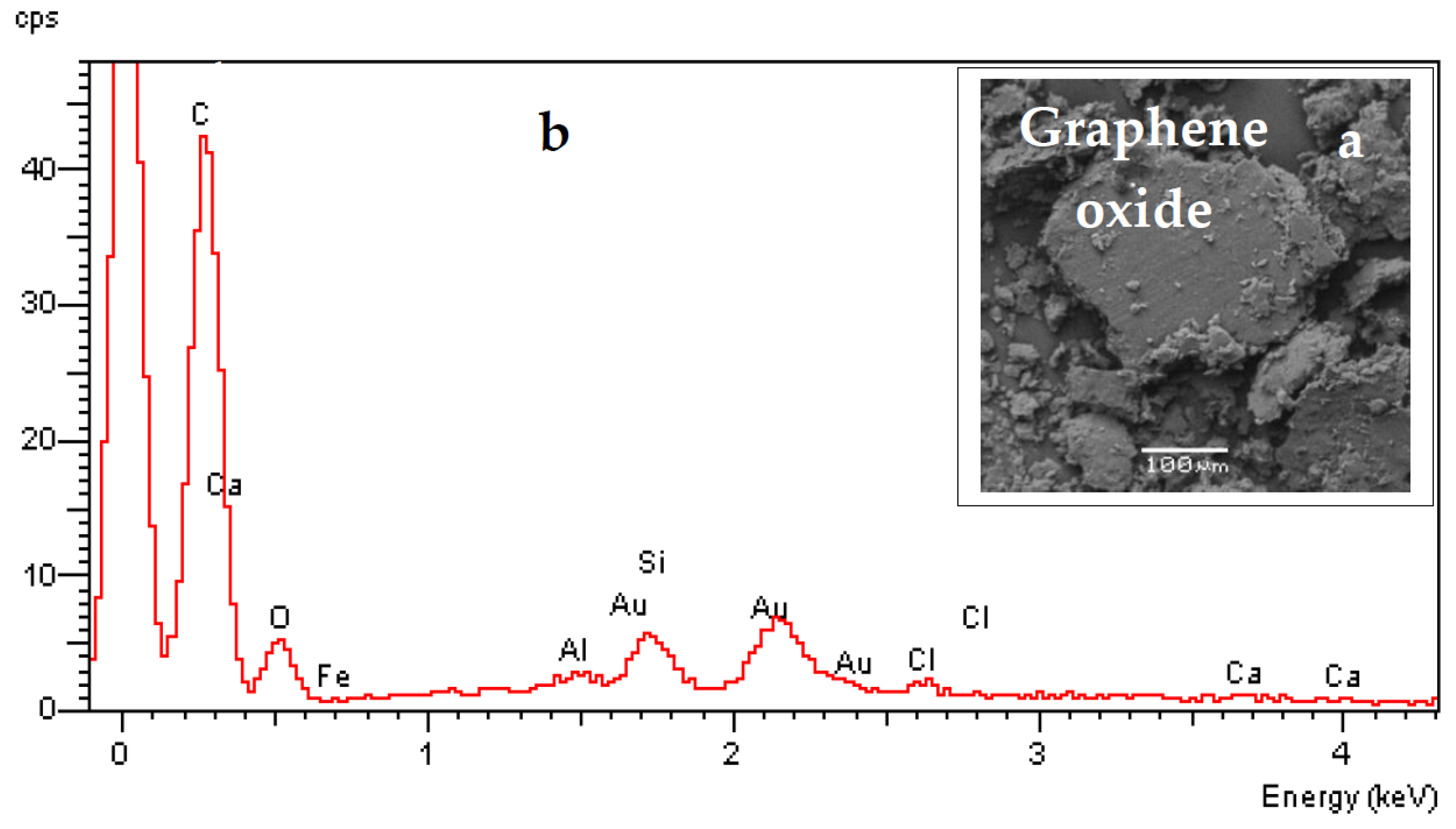
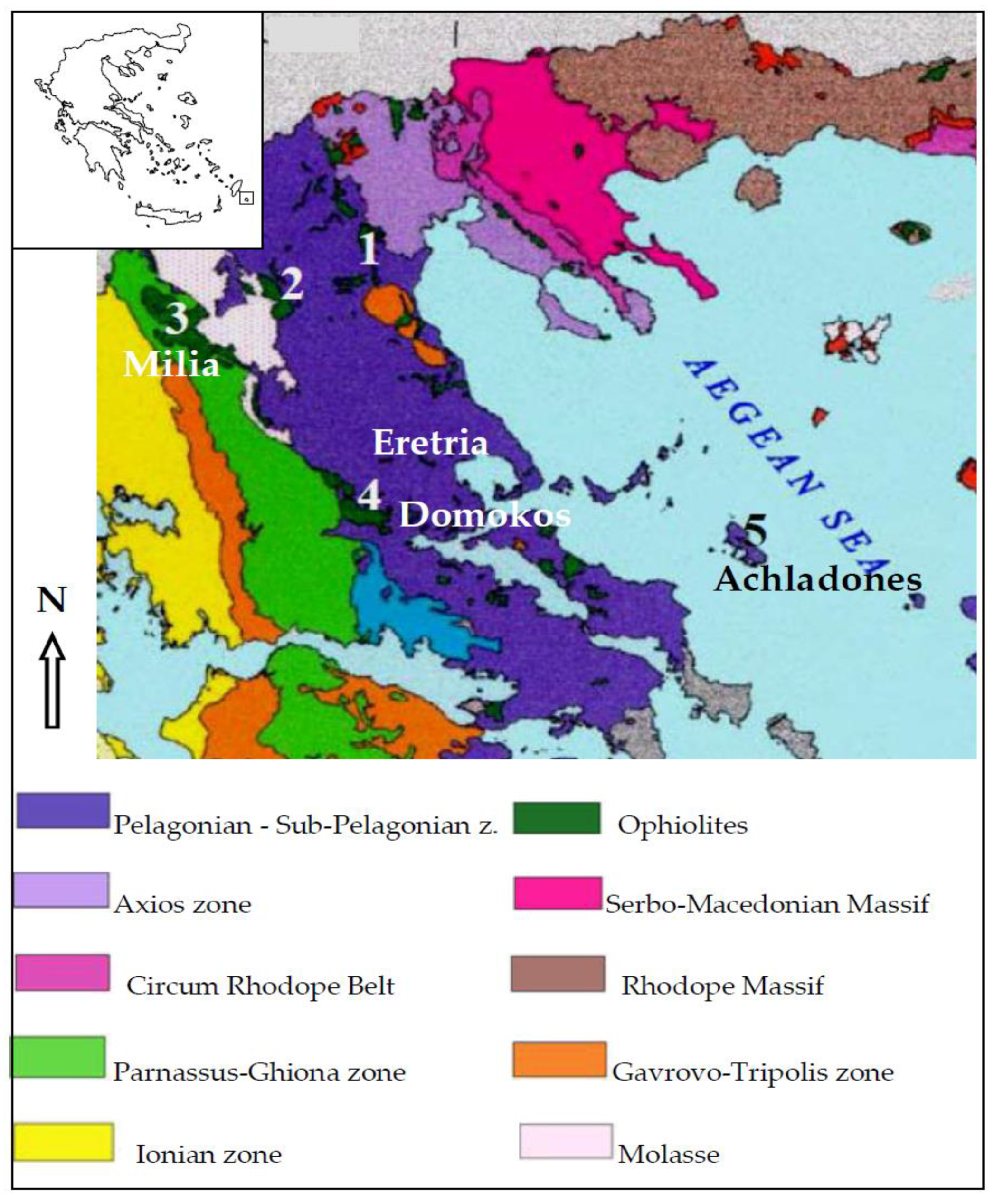
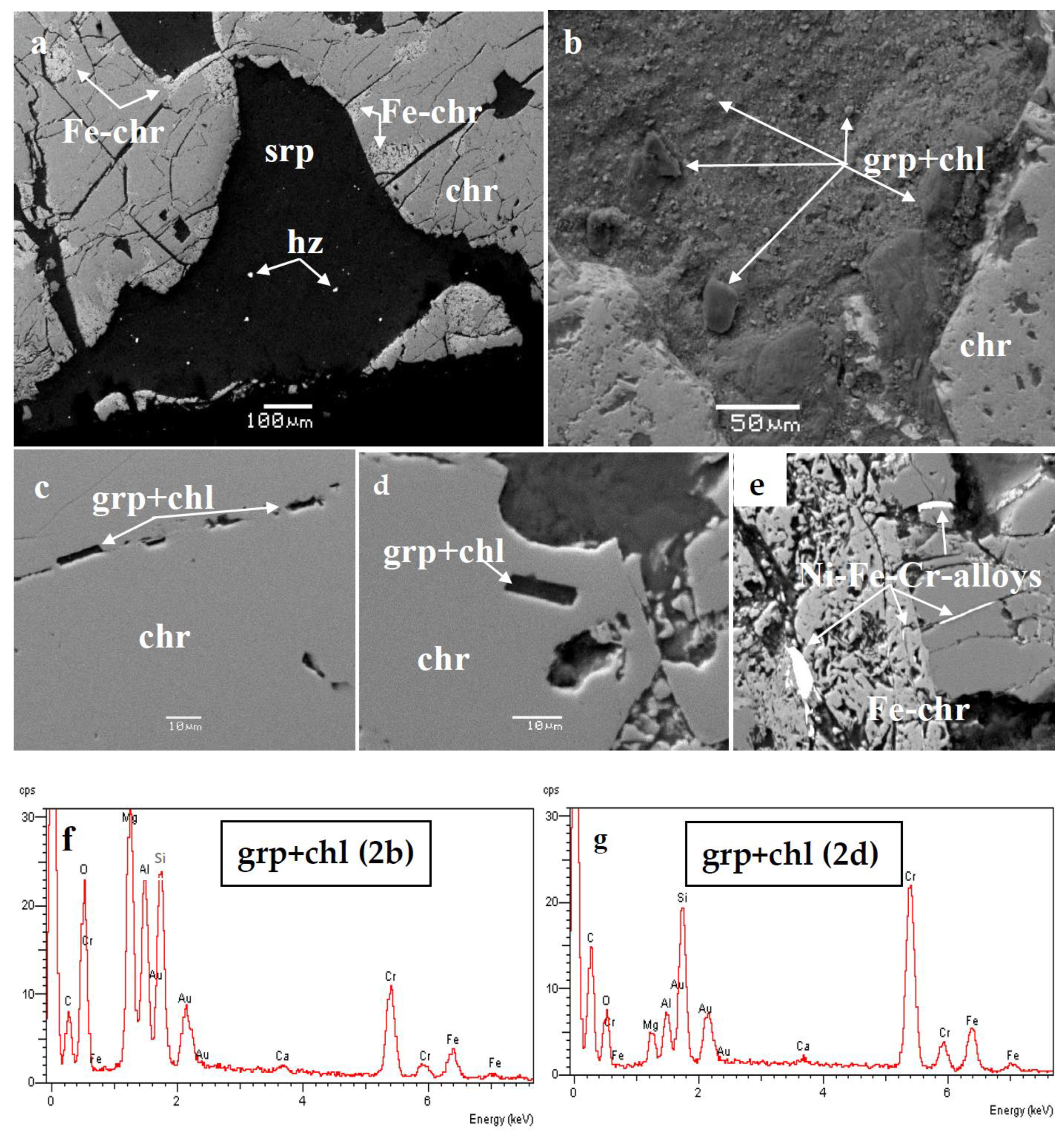
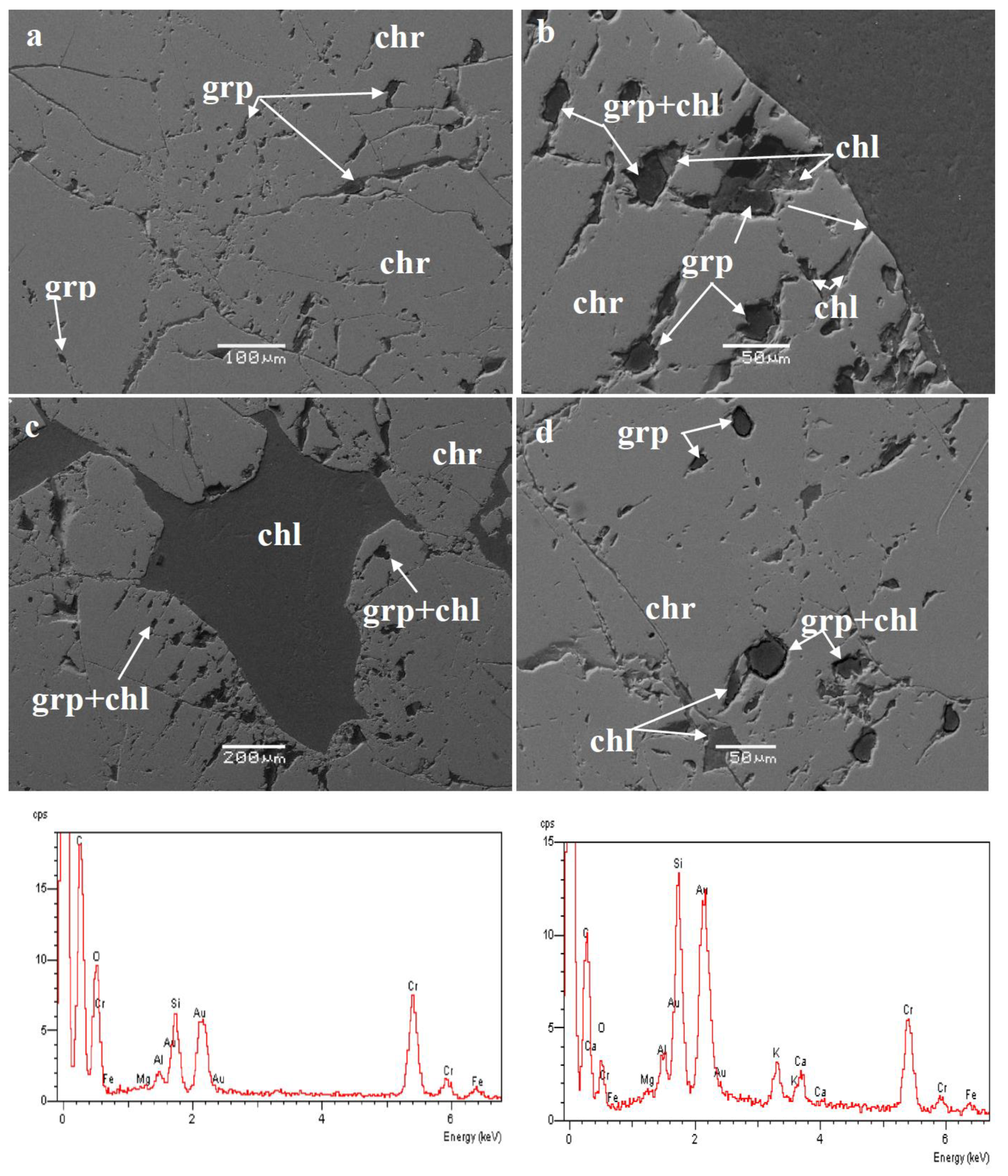
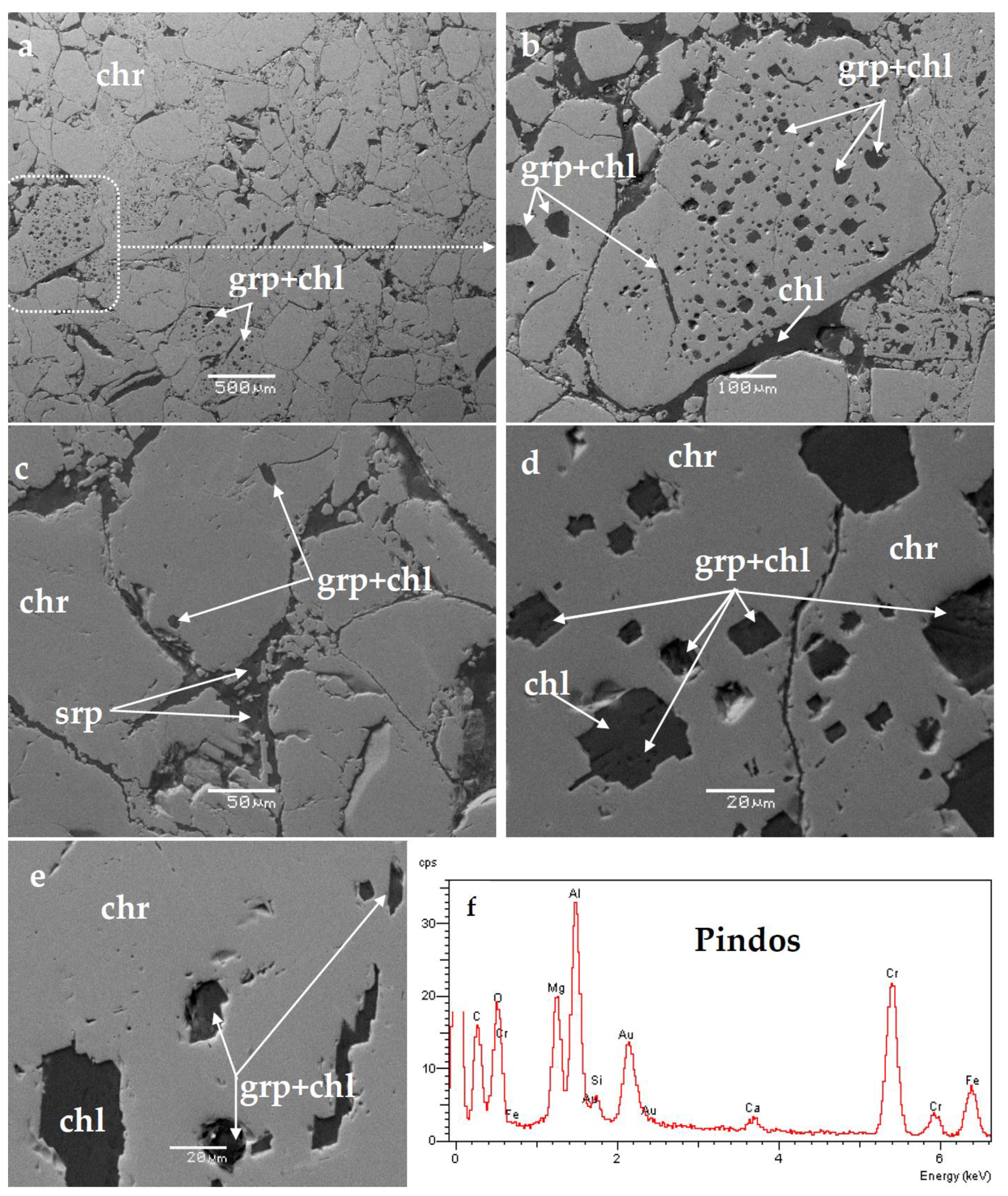
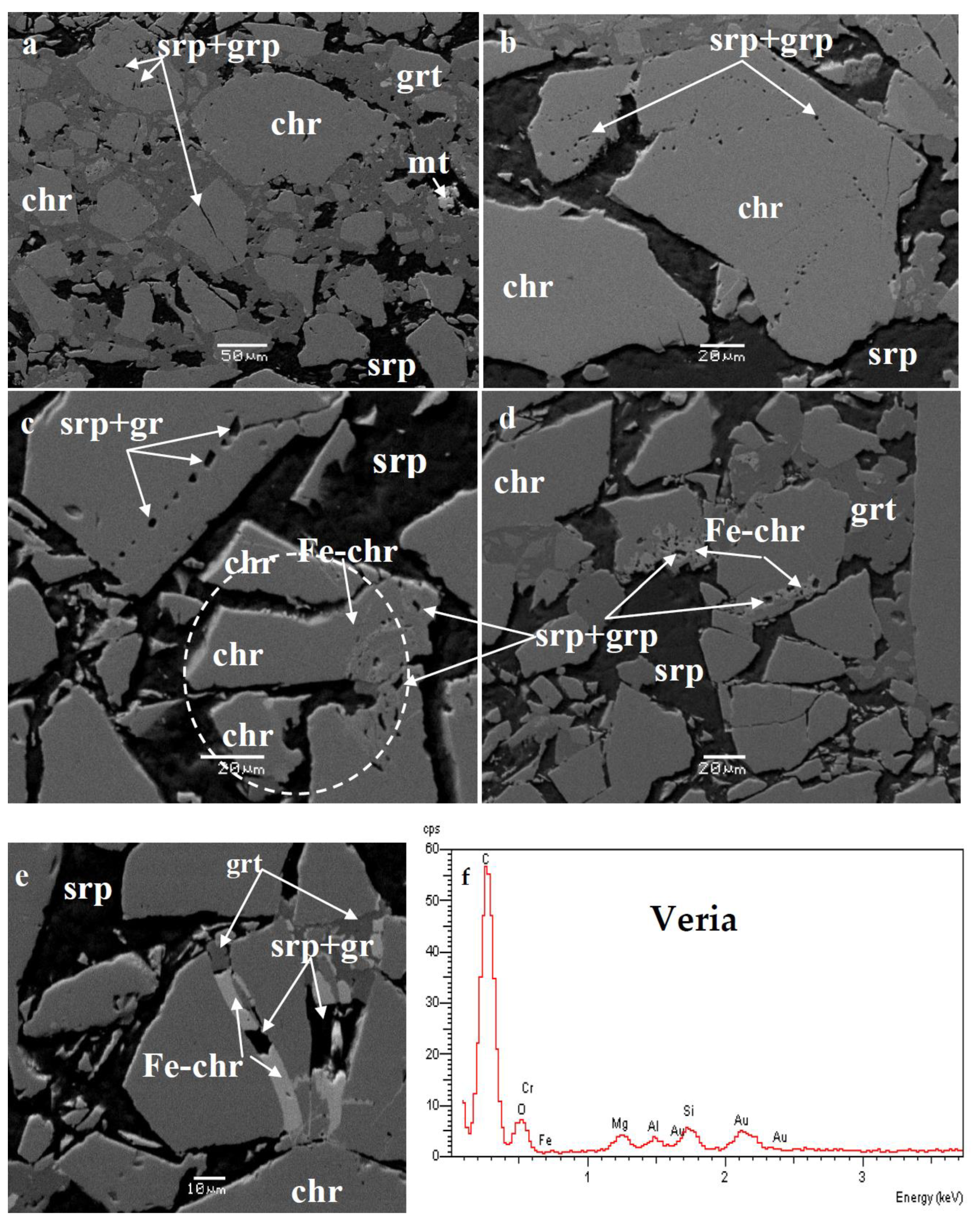
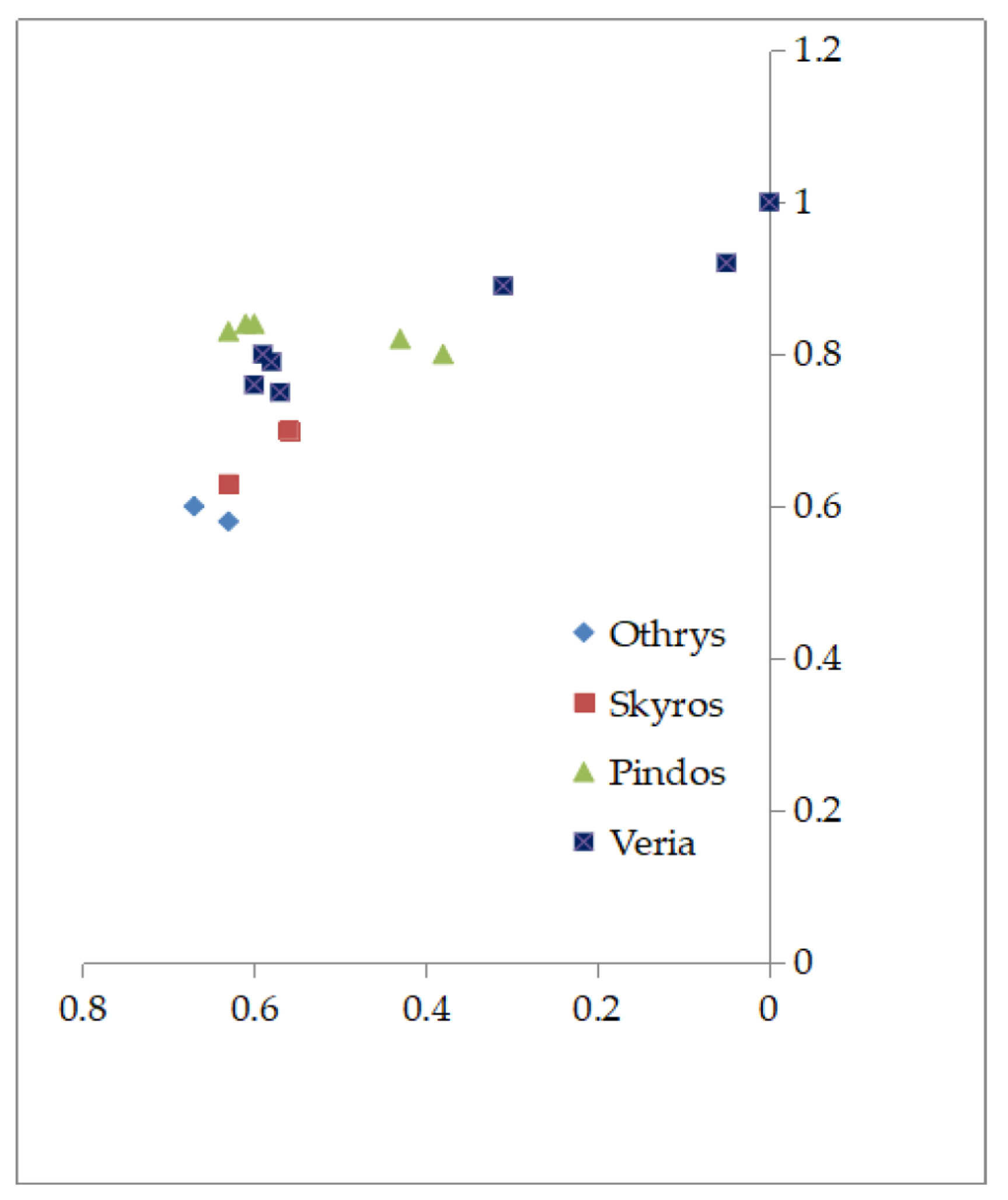
| Location | Skyros | Skyros | Othrys | Othrys | Pindos | Pindos | Veria | |||||
|---|---|---|---|---|---|---|---|---|---|---|---|---|
| Achladones | Eretria | Eretria | Milia | Milia | Figure 6 | |||||||
| wt. % | Figure 3, core | Figure 4, core | Figure 5, core | Core | Core | Core | Figure 6c | Figure 6d | Figure 6e | |||
| Al2O3 | 14.5 | 19.2 | 21.4 | 22.2 | 9.6 | 8.2 | 12.8 | 12.8 | 10.3 | 4.5 | 0.6 | n.d. |
| Cr2O3 | 50.7 | 49.1 | 47.2 | 46.5 | 56.9 | 59.4 | 57.4 | 57.3 | 60.9 | 55.2 | 11.1 | 19.4 |
| Fe2O3 | 6.7 | 3.3 | 4.1 | 3.9 | 3.5 | 3.4 | 2.1 | 1.73 | 1.1 | 10.4 | 57.1 | 49.1 |
| MgO | 11.6 | 13.5 | 14.8 | 15.6 | 7.7 | 8.5 | 12.5 | 12.2 | 12.1 | 5.9 | 0.9 | n.d. |
| FeO | 16.51 | 14.2 | 12.8 | 12.6 | 21.6 | 20.2 | 14.7 | 15.1 | 15.1 | 23.4 | 29.7 | 31.3 |
| Total | 100.01 | 99.3 | 100.3 | 99.8 | 99.3 | 99.7 | 99.5 | 99.1 | 99.5 | 99.4 | 99.4 | 99.8 |
| Cr/(Cr + Al) | 0.7 | 0.63 | 0.6 | 0.58 | 0.8 | 0.82 | 0.76 | 0.75 | 0.8 | 0.89 | 0.92 | 1.00 |
| Mg/(Mg + Fe2+) | 0.56 | 0.63 | 0.67 | 0.63 | 0.38 | 0.43 | 0.6 | 0.57 | 0.59 | 0.31 | 0.05 | 0.0 |
| Skyros | Othrys | Pindos | Veria | Detection Limit | |
|---|---|---|---|---|---|
| Achladones | Eretria | Milia | Galaktos | ||
| ppb | |||||
| Os | 140 | 24 | 150 | 7400 | 2 |
| Ir | 480 | 13 | 320 | 6020 | 2 |
| Ru | 1200 | 45 | 350 | 9700 | 5 |
| Rh | 160 | 3 | 82 | 310 | 1 |
| Pt | 280 | 8 | 150 | 760 | 5 |
| Pd | 39 | 1 | 8 | 750 | 1 |
| ΣPGE | 2300 | 94 | 1060 | 24,940 | |
| Pd/Ir | 0.08 | 0.08 | 0.02 | 0.12 | |
| Cr # | 0.61 | 0.56 | 0.82 | 0.79 | |
| Mg # | 0.64 | 0.64 | 0.42 | 0.66 | |
| ppm | |||||
| Ni | 800 | 1350 | 1200 | 900 | 0.1 |
| Co | 250 | 230 | 350 | 200 | 0.2 |
| V | 890 | 1020 | 980 | 860 | 1 |
| Zn | 510 | 380 | 970 | 600 | 0.2 |
© 2019 by the authors. Licensee MDPI, Basel, Switzerland. This article is an open access article distributed under the terms and conditions of the Creative Commons Attribution (CC BY) license (http://creativecommons.org/licenses/by/4.0/).
Share and Cite
Economou-Eliopoulos, M.; Tsoupas, G.; Skounakis, V. Occurrence of Graphite-Like Carbon in Podiform Chromitites of Greece and Its Genetic Significance. Minerals 2019, 9, 152. https://doi.org/10.3390/min9030152
Economou-Eliopoulos M, Tsoupas G, Skounakis V. Occurrence of Graphite-Like Carbon in Podiform Chromitites of Greece and Its Genetic Significance. Minerals. 2019; 9(3):152. https://doi.org/10.3390/min9030152
Chicago/Turabian StyleEconomou-Eliopoulos, Maria, George Tsoupas, and Vasilis Skounakis. 2019. "Occurrence of Graphite-Like Carbon in Podiform Chromitites of Greece and Its Genetic Significance" Minerals 9, no. 3: 152. https://doi.org/10.3390/min9030152
APA StyleEconomou-Eliopoulos, M., Tsoupas, G., & Skounakis, V. (2019). Occurrence of Graphite-Like Carbon in Podiform Chromitites of Greece and Its Genetic Significance. Minerals, 9(3), 152. https://doi.org/10.3390/min9030152






